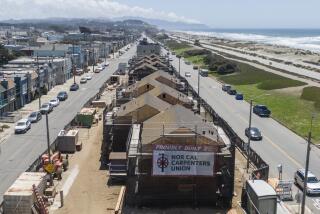Putting Home Price Forecasts in Perspective
Predictions about residential real estate are becoming scary--that house prices in the New York and Boston areas will fall eventually to levels of Texas and Oklahoma; that California home prices will fall 5% to 10% on a statewide basis--more in big cities.
Those are the prospects outlined in Barron’s financial weekly and Forbes magazine by analysts and investment managers. And they’re sure to get attention, because for most people house values represent 60% of their net worth. But before you run screaming for shelter, let’s see what’s behind such predictions.
In Barron’s, the money managers of a firm named Comstock Partners say burdens on the economy from the savings and loan bailout and the high levels of corporate and individual debt will affect house prices. “Property values in Oklahoma, Texas and Arizona are more consistent with what the future will hold than property values in New York, Boston and Washington. Somewhere the values will equalize,” says Michael Aronstein of Comstock, speaking in terms of the next five to 10 years.
The Comstock Partners are the guys who predicted a year ago that real estate prices in the Northeast would tumble, and so far they’ve been right. House prices in the New York-New Jersey-New England area, after an incredible run-up of 150% to 200% from 1983 to 1987, have fallen 10% to 20%--and more in some locations.
Meanwhile, the West Coast is not immune. In a report for the brokerage Donaldson, Lufkin & Jenrette, analyst Timothy Hurckes predicts that California house prices will decline 5% to 10% on a statewide basis next year.
In fact, the decline is already here, says Edward Abbott, head of Western Pacific Capital, a San Francisco-based real estate investment firm. “The merchandise isn’t moving in Orange County and the (San Fernando) Valley,” says Abbott, and in San Francisco (unrelated to the earthquake) “asking prices are 20% below what they were last March.”
So, are house prices in wholesale retreat, as in the 1930s when foreclosures were common and Los Angeles properties lost half their value? No, don’t panic. What is happening is that in some markets--the Northeast, San Francisco, some areas of Los Angeles--prices that were pushed up by the financial boom of the early to mid-1980s, are now going into a down cycle.
But elsewhere, prices are rising. In the Central Valley, “in Tracy, Fresno, Sacramento--wherever real people can afford to buy a real house, markets are good,” Abbott says.
And elsewhere in the country, too, real estate values are on the rise in industrial areas such as Cincinnati and Columbus, Ohio, and in places that went through severe depression in the 1980s--such as Houston and San Antonio.
What all this means to you is don’t be scared by predictions, but do get a perspective on real estate values. They rise and decline in a market like any other but often without the trading that constantly sets stock and bond prices. In real estate, if houses aren’t selling, people don’t move as often--and so prices fall invisibly, as it were. The experts are saying that now is such a time, that real estate in many places is going into a down cycle, so you can’t count on appreciation.
But as for $300,000 houses in the Northeast or Los Angeles tumbling to the $90,000 levels of Oklahoma City, that’s not going to happen, says Christopher Leinberger, a real estate consultant and author on urban patterns. Land, population and politics are the reasons. In large urban areas, land use is restricted by zoning and the power of community groups to control developers, Leinberger says.
A zoning ordinance saying only two houses can occupy an acre of land--rather than four houses or a bunch of apartments--reduces the overall amount of land available to construction and drives up land and home prices. That helps account for the high property prices in dense urban areas--which make up only 2.2% of the total U.S. land area.
But such zoning also restrains overbuilding, so that dense urban areas don’t suffer horrendous declines such as Houston experienced and such as Arizona is now going through. “After this economic pause, the direction of prices in Boston and Los Angeles is higher, more toward the patterns of Europe and Japan rather than those of the Midwest,” Leinberger says.
Dense urban areas also generate diverse economies that are better able to withstand an economic downdraft in a single industry. “The economy is more diverse and incomes per person are higher in California than they were in Texas,” notes real estate investor Abbott (who nonetheless is most bullish right now about Houston and San Antonio).
Which only means that despite scare headlines and predictions, economies remain cyclical--and this cycle too shall pass. And though a house may not be a money-making investment right now, it usually beats inflation over the long term, aside from being a nice, tax-deductible place to live.
More to Read
Inside the business of entertainment
The Wide Shot brings you news, analysis and insights on everything from streaming wars to production — and what it all means for the future.
You may occasionally receive promotional content from the Los Angeles Times.










